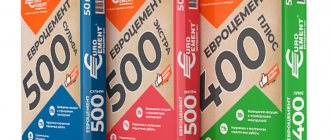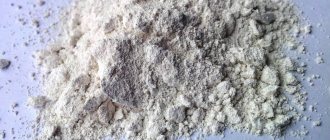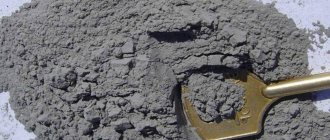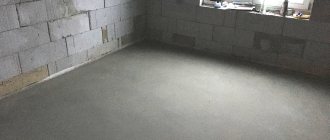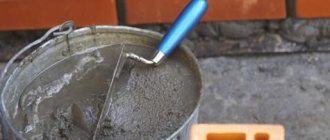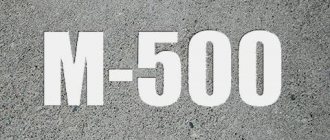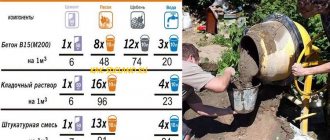Cement is an artificial powdery substance that, as a rule, acts as a binder between components when mixing special concrete mixtures for construction and repair work. These mixtures have a wide range of applications: construction of residential buildings, creation of industrial facilities, repair and finishing work and for many other purposes. M500 cement is considered to be the highest quality binder component, which is used primarily for the construction of the main structural elements of houses and other objects.
M500 cement manufacturing technology
The raw materials for the production of Portland cement M500 are gypsum stone, clinker (a product of sintering clay and limestone), blast furnace charge, as well as plasticizing, acid-resistant and hydrophobic additives. For special types of material, some other components may be used. The technological process of cement production is divided into two enlarged stages, which in turn are divided into separate stages.
The first stage is the production of clinker, which is essentially the basis of a dry cement mixture. Clinker is obtained from a special mineral - brilliant green or yellowish-green limestone, which is mined from a depth of up to 10 m during the development of limestone deposits. Yellowish-green limestone is industrially pre-dried and then mixed with other components. After firing, the clinker is ready for subsequent technological operations.
At the second stage, the clinker is crushed to a powdery consistency with the addition of gypsum and special additives. The result is a loose, homogeneous mass. Depending on the quality and condition of the feedstock, it is possible to use one of three industrial methods for producing conditioned material: wet, dry or combined.
With the dry method, mixed raw materials are dried immediately before grinding or during the grinding process. After grinding the components into powder, the mixture is treated with burning gas. This method is now considered the most promising and economical in terms of energy consumption. The wet method involves preliminary grinding of raw materials in water. The resulting aqueous suspension is fed into the furnace and fired. At the end of the process, the formed granules are crushed to obtain the finished cement. The combined method combines both of the above technologies in different versions. Moreover, in one case, after dry preparation of the mixture, granules are formed with the addition of water, and in the other, grinding of the mixture in water is followed by its drying and firing.
Buying Tips
When choosing the M500 cement composition, you should carefully study the product and pay attention to the following nuances:
- weight. When purchasing, you should weigh the bag of building materials to make sure there is no underweight;
- date of manufacture. The fresher the material, the better its performance characteristics;
- manufacturer contacts. The packaging must indicate the address of the production complex and office of the manufacturer, as well as a landline telephone number.
To buy this building material, contact our company.
Consumer qualities and main technical characteristics of M500 cement
The main operating parameter of cement, which determines its grade, is the strength of the hardened water-cement mixture, that is, its resistance to external load. Other basic characteristics of the material are its density, setting time, water and frost resistance.
2.1. Strength
It is the compressive strength of Portland cement, expressed in kg per cm2, that is included in the marking of the material, defining its type. This means that M500 cement, after mixing with water and hardening for 28 days, is able to withstand loads of at least 500 kg per square centimeter of a flat surface. This strength (in the modern classification - from 42.5 MPa) is considered high and is recognized as optimal for most critical construction work. It should be taken into account that the setting speed of the described material is shorter than that of cements of less durable brands.
2.2. Bulk and surface density
The M500 cement density parameter is necessary for rational calculation of the amount of material in the mixture during construction work. The density of the material can be bulk or true.
The bulk density of cement is the specific gravity of the loosened material, taking into account the air particles present in it. This characteristic helps to estimate the actual proportions of the solution and is used in practice. For Portland cement M500, the bulk density varies from 1100 to 1300 kg per cubic meter, but after transportation it often increases to 1400-1500 kg per cubic meter. The true density of cement is determined by the specific gravity of the mixture without air particles. It exceeds the bulk volume by almost 2 times and for M500 cement is about 2500 kg per cubic meter.
To calculate the amount of ingredients of a concrete-mortar mixture, a volume-measured amount of material is poured into a separate vessel, then it is weighed and the result is divided by the volume of the container. In a similar way, determine the required amount of additives in the solution (sand, etc.). Typically, in mass construction, an average bulk density of 1200-1300 kg per cubic meter is used. The average weight of a cube of Portland cement M500 is 3 tons with a standard grinding fineness of 92%. At the same time, gypsum additives lighten the volume, and slag additives make it heavier.
2.3. Frost resistance
For M500 grade material, the guaranteed frost resistance is at least 70 cycles of complete freezing-thawing of the hardened mixture (F70). Thanks to this, the material can be used in regions with sharp climatic changes, including for winter concreting.
2.4. Water resistance
M500 cement without impurities has normal water resistance, allowing it to be used in the construction of residential, office and industrial buildings. However, when constructing foundations, swimming pools and other concrete tanks, it is recommended to use material with index D20, which contains special additives that are responsible for the additional resistance of the mixture to constant exposure to moisture.
2.5. Setting time of liquid mixture
Portland cement M500 is a material with accelerated hardening, which makes it possible to effectively use it both in conventional construction and in the process of repair and emergency work. In this case, the strength qualities of the mixture begin to appear no later than 45 minutes after use, the initial hardening occurs after 10-12 hours, and 50% hardening occurs in three days.
Which is better?
On the shelves of construction stores you can find several types of cement mixtures with different labels. The letter M indicates the strength of the cement, and the numbers indicate the weight of the compressive load. The M200 marking indicates that the structure will withstand a load of 200 kg per 1 cm³ without destruction, the M300 marking means that the product has a compressive strength of 300 kg per 1 cm³, and so on.
When purchasing building mixtures, it is necessary to study the technical characteristics of each type of cement.
- M100 – has a low level of strength (10 MPa), used for masonry work, plastering, and sealing joints.
- M200 - used for the production of masonry mortars, paving paving slabs, for the production of weak concrete mortars, for sealing cracks. Gains strength at high indoor humidity. Setting occurs in 120 minutes, strength is up to 22 MPa.
- M300 is a popular material with an affordable price. It is used for the production of concrete mixtures, floor screeds, wall cladding and grouting. Setting time is 80 minutes, strength is 30 MPa.
- M400 - used for installation of all types of foundations, for the manufacture of columns, for mixing mortars. The beginning of setting occurs after 2 hours, the strength is 40 MPa.
- M500 is a popular type of building material with a strength of 50 MPa. It is used in facilities with high requirements and increased loads.
- M600 - used for the construction of military facilities, has a strength of 60 MPa, setting occurs in 45 minutes.
- M700 - used at facilities of national importance, has a high price and a strength of 70 MPa.
Manufacturers of cement mixtures note that the higher the grade of the material, the higher the strength of the resulting concrete. To obtain a low-grade solution, you need to take a small amount of binder material. Knowing the proportions and design of cement mortars, you can significantly reduce the estimated cost of the work.
To independently purchase cement mixtures, professional builders advise following some rules:
- choose products from well-known brands;
- carefully look at the weight of the packaged goods;
- check the production date and service life;
- study the technical specifications indicated by the manufacturer on the packaging.
Pure cement M500 and its special types
Pure or clinker cement M500, free from mineral additives and impurities (index D0), has a fairly low cost and is widely used in construction. Masonry and industrial concrete structures using it can withstand static loads well, are strong, durable and frost-resistant. Construction experience shows that the reliability of buildings based on M500 Portland cement is much higher than those using M400 material.
Certain types of material are produced with a standardized content of modifying or technological additives, which help speed up the grinding process of the gypsum-clinker mixture, increase the frost and moisture resistance of the hardened material, accelerate hardening, etc.
Among the special types of M500 cement offered on the domestic market, the following are actively used:
- fast-hardening cement BTC, in demand in high-speed construction;
- sulfate-resistant Portland cement SSPC, used in the construction of massive foundations, dams, piers and structures that are under constant influence of groundwater with sulfates;
- material with surface-active components (PL) with increased plasticity;
- GF cement with minimal water permeability, used in specific conditions;
- Portland cement VRC (waterproof expanding) with high density, used in mine structures and when sealing cracks in water pipes;
- grouting cement for plugging boreholes;
- decorative colored cement white (BC) or colored.
The weight amount of additives in M500 cement relative to the original clinker mixture according to the state standard can be in the range of 0-20%, which is reflected in the factory marking of the material after the letter D.
Advantages
This brand of cement has many advantages:
- • moisture resistance;
- • frost resistance;
- • strength;
- • slight shrinkage and deformation during hardening;
- • possibility of long-term resistance to low temperatures.
Thanks to the above-mentioned properties, M500-based mortar can be successfully used in the coldest weather, which allows the pace of construction to be accelerated.
With the many advantages of this material, it is quite logical that it also has some disadvantages.
This cement is quite capricious and requires careful adherence to the recommendations specified by the manufacturer. It is very important to keep construction tools and formwork clean. It is not recommended to use this cement in places with high groundwater levels with a large amount of minerals - such water can reduce the quality of the finished solution.
Marking of cement M500 according to old and new GOST
Marking of Portland cement M500 is still carried out either according to the outdated state standard GOST 10178-85 or according to the updated GOST R 31108-2003 with additions from 2016.
In the first case, the initial letters of the designation will be PTs (Portland cement) or ShPTs (slag Portland cement), followed by the index M500, indicating the grade of material. In this case, the letter M is often skipped. This is followed by information about the percentage of impurities - D5, D10, D15, D20, and then about the special properties of cement. An example of such marking is PC-500-D10-SS GOST 10178-85, that is, Portland cement grade 500 with ten percent impurities, sulfate-resistant.
According to the GOST R 31108-2003 standard, consistent with European standards EN 197 1, the strength properties of cement are expressed in megapascals (MPa). In the domestic version, the marking of the material begins with the letters CEM followed by the Roman numeral I or II, respectively, indicating the absence/presence of mineral additives in it. Here, number I means cement made from ground clinker and technological additives in an amount of up to 5% by weight of the material, and number II means the presence of additives in a mass fraction of 6%-35%. Portland cement with impurities has an additional index A (6%-20% additives) or B (21%-35% additives). At the end of the designation there may be a letter N or B, indicating the rate of hardening of the mixture - normal or fast. An example of such marking for M500 cement is CEM II/A 42.5N, that is, M500 cement with a proportion of impurities of 6%-20% and a normal hardening rate.
Pros and cons of the material
Among the operational advantages of Portland cement M500, which make the material attractive for various areas of construction activity:
- ease of use, since here the preparation of the solution comes down to thoroughly mixing a mixture of water, cement, sand and, if necessary, crushed stone in specified proportions;
- chemical inertness, which implies resistance of finished concrete products and building structures to corrosion, exposure to alkalis, salts and acids;
- environmental friendliness, since the material does not contain toxic substances, the fumes of which can cause harm to humans and the environment;
- the optimal combination of strength, moisture resistance and durability of finished structures;
- moderate consumption of building materials, helping to minimize the developer’s costs.
The only significant drawback of M500 cement is its cost, which is slightly higher than that of lower grades of material. This partly constrains its use in the construction of unloaded structures and buildings that are not subject to special external aggressive influences.
Main advantages
M500 cement has a number of the following advantages:
Construction mixtures based on this binder component tolerate significant temperature changes and high humidity without significant loss of strength.
- Structures made from such concrete have a long service life of more than 100 years.
- When hardening, construction mixtures based on M500 cement do not shrink.
- The absence of corrosion allows the mixtures to be used for finishing facades and creating decorative decorations.
- Cement is an environmentally friendly building material with no restrictions on its use.
- Reasonable price for all categories of buyers.
- Chemical inertness allows the use of finished reinforced concrete products and structures under conditions of exposure to aggressive alkalis, acids, and salts.
- Moderate consumption of this material allows you to optimize the costs of constructing objects.
Areas of application of Portland cement M500
The working properties of M500 cement have determined the wide range of applications of the material. Among the areas of mass use of building mixtures based on it:
- construction of foundations for residential multi-storey and capital industrial construction projects;
- construction of shopping centers, large-capacity warehouses, port facilities, train stations and public buildings, including on water-saturated soils;
- repair and emergency restoration work on concrete structures and buildings;
- construction of overpasses, bridges, dams, locks, power line supports;
- development of high-traffic highways;
- production of massive reinforced concrete slabs (airfield, road, etc.).
In addition, Portland cement M500 is used in special cases when mixtures with rapid hardening and guaranteed strength are needed (creating floor screeds, decorative park elements, etc.).
Manufacturers
The annual increase in demand for cement grade M 500 leads to the constant emergence of new manufacturers of building materials. The leaders in the production of high-quality building mixtures of the M500 brand are the French company Lafarge and the Swiss Holcim . The merger of two large manufacturers into one LafargeHolcim brand led to an increase in production capacity and the supply of products to more than 100 countries.
The use of innovative production technologies and high-quality raw materials leads to a constant improvement in the technical characteristics and properties of products. Particular attention is paid to the production of sulfate-resistant types of cement for work in climatically difficult regions. Affordable prices and high quality products of this brand allowed it to take first place in the ranking of sales of building mixtures. To increase the production of cement mixtures, LafargeHolcim is working on opening new branches in different countries of the world.
The LafargeHolcim brand has developed a new type of cement, ExtraCem, for strategic facilities, which has a high hardening speed and frost resistance.
The products of this brand have a number of differences and advantages:
- unique compatibility with various chemical components;
- long period of operation;
- high level of strength;
- mobility;
- resistance to low temperatures and high humidity.
Russian manufacturers of building mixtures are the main competitors for European companies. The products are in deserved demand among customers, and low prices and high quality make them indispensable in carrying out construction work of any complexity and in different climatic regions.
On the shelves of construction stores you can find products from the Mexican company Cemex . The cement of this brand has a low price and is produced using high-class equipment in accordance with European standards.
The unique technical characteristics, strength and durability of the building material allowed it to take a leading position in the ranking of sales of cement products. The affordable price of the material significantly reduces the estimated cost of the project, and the high hardening speed reduces the time required for construction work and physical costs.
Detailed instructions and technical characteristics of the product indicated by the manufacturer on the packaging and professional consultants from construction stores will help you choose the required type of material. Only the use of high quality materials from well-known manufacturers will allow the construction and operation of the planned facilities to be completed.
To learn how to choose cement, watch the following video.

